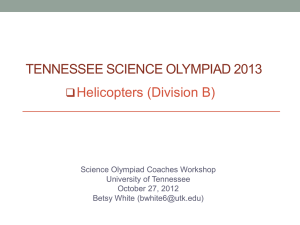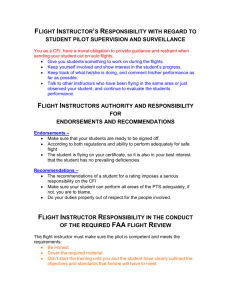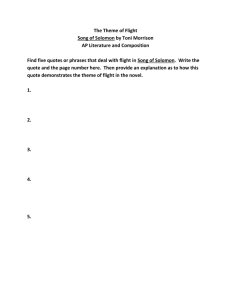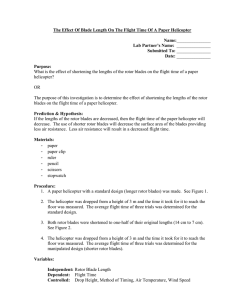Helicopter Duration - the Empire State chapter of AHS
advertisement
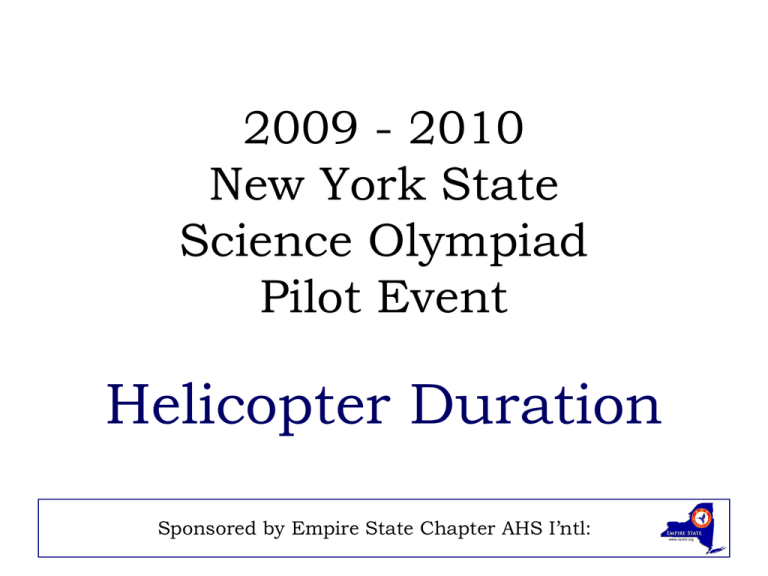
2009 - 2010 New York State Science Olympiad Pilot Event Helicopter Duration Sponsored by Empire State Chapter AHS I’ntl: Helicopter Duration 1. 2. 3. 4. DESCRIPTION CONSTRUCTION SPECIFICATIONS THE COMPETITION SCORING National Science Education Standard: http://www.soinc.org/events/wrightstuff State Event Is Sponsored By The Empire State Chapter of the American Helicopter Society International http://www.NYVTOL.org 1. DESCRIPTION: Teams of one or two persons will construct and test free flight rubber-powered helicopters to achieve maximum flight times. 2. CONSTRUCTION SPECIFICATIONS: a. DESIGN: b. MATERIALS: c. MASS: d. ROTORS: e. CONSTRUCTION: f. TRANSMISSION: g. POWER: h. MARKING: 2.a. DESIGN Helicopters may be constructed from: • Published plan(s) = OK • Commercial kits = OK • Student’s Original Design = OK NO LIMITATION: Wide Open NOTE: See also 2.e. Construction. Commercially available rotors or propellers shall not be used. 2.b. MATERIALS Construct ONLY from: • • • • wood paper plastic film covering Glue Components May be attached using: • • • • • thread music wire malleable wire paper or plastic tubes rubber bands May use: • Plastic or rubber o-rings to attach the motor to the helicopter rotor(s) May NOT use: • Pre-glued joints • Pre-covered surfaces See also 2.e. Construction Refers to Commercial Kits 2.b. MATERIALS (Continued) JB Weld and other Epoxy Resins (Glues) May be used as a glue to fasten pieces together but not as major structural members (ie a motor stick or spar) Roller bearings may be used and have no limit on type. Plastic bushings may be used and may also be commercially available. No Metal for anything other than bearings and connecting wires. But this is still pretty broad. Prop shafts connect things, so do motor hooks. But certainly not as a wing spar or structural member like that. No Fiberglass. Glass is not listed as allowed in Para 2.b Foam (Styrofoam etc) is not allowed as a structural member like a rotor blade, spar, etc. Foam is a plastic and could be used as a connecting material. Plastic is acceptable for connecting tubes, film covering and o-rings. The rules do NOT allow plastic tubes as a structural member, only connecting device. Composites such as carbon fiber are NOT allowed. Composites of the basic materials (wood, glue, paper, plastic film) meet the rule as I see it. Tapes may be used because they are a composite or combination of glue and paper or glue and plastic film. 2.c. MASS Total mass of the helicopter throughout the flight, excluding the rubber motor, must be 4.0 grams or more. 4.0 grams or more at all times (Excluding Rubber Motor) 2.d. ROTORS Rotors = surfaces that contribute lift by rotating around a vertical axis. • • • • • Use up to three fixed pitch rotors. 40.0 cm Max Rotor diameter No maximum number of Rotor Blades No maximum Rotor Blade Chord No other lifting surfaces are permitted. 2.d. ROTORS (Continued) Hub Thrust Drag Blade Rotors require power to spin the blades, develop thrust and to overcome blade drag. 2.d. ROTORS (Continued) Hub = Center of rotation, used to attach Rotor Blades Rotor Blades = Primary lifting agent in Rotor using airfoil cross section and rotational velocity to generate Lift Lift = (coefficient of lift)(Q)(S) (coefficient of lift) = An expression of how well an airfoil produces Bernoullian lift (Q) = ½ Rho (Density Ratio) times the square of the velocity of the relative wind (S) = The surface area of the airfoil Angle of Attack = Relation between Blade Cross Section and Airflow, used to determine coefficient of lift Thrust = sum of Lift from Rotor Blades 2.d. ROTORS (Continued) Fixed Pitch = Each blade installed in Hub at set Angle of Attack (AoA), Thrust is varied by rotational speed, not control of AoA Rotor Radius = Distance from center of Hub to tip of Rotor Blades Rotor Blade Chord = Distance from Leading Edge of Rotor Blade to Trailing Edge Blade Cross Section = Airfoil shape used to generate lift Chord 2.e. CONSTRUCTION Students shall construct the rotors themselves. Commercially available rotors or propellers shall not be used. (Building/Designing the rotors is the single biggest challenge of this event) Bearings, rotor thrust bearings may be commercially available items. 2.f. TRANSMISSION Between Rubber Motor and the Rotors: • No gears • No pulleys • No rollers * • No means of changing mechanical advantage Rotor Thrust Bearings are allowed by 2.e. Construction * Roller Bearing type Rotor Thrust Bearings are OK ! 2.g. POWER The helicopter will be powered by rubber motor(s) not exceeding a total mass of 2.0 grams (including any attachments such as o-rings). The motor(s) will be massed separately from the helicopter. Motors may be lubricated before and/or after check-in. (lube has weight) Motors will be massed at check-in, and officials will clearly mark and impound qualified motors, which will be made available to the team for official flights. 2.h. MARKING Each helicopter must be labeled in such a way as to be easily identified by the event supervisor. 3. THE COMPETITION: a. b. c. d. e. f. g. h. i. j. k. l. m. FLYING SPACE: SPORTSMANSHIP: FLIGHT LOGS: PRACTICE FLIGHTS: (self-check inspection) (Motor Winder) CHECK IN and PREPARATION: FLIGHTS: (Flight Period - 8 minutes) MOTORS: TIMING: CONCURRENT FLIGHTS: STEERING: 3.a. FLYING SPACE: The event must be held indoors. The room dimensions shall be made available to teams in advance of the competition. (approximate length, width and ceiling height) Directors and supervisors are urged to minimize the effects of environmental factors such as air currents (e.g., doors, fans) by pre-arranging for ventilation to be turned off, windows to remain closed, and doors to be kept closed during flights. 3.b. SPORTSMANSHIP: No persons may attempt to give teams outside assistance, materials or communication, once teams enter the flight room on the day(s) of Helicopter Duration competition, This applies to any trim periods as well as during the official flying schedule. Teams violating this rule will be disqualified. Competitors may offer assistance to other teams. A separate area will be designated for spectators, who may not interact with the teams except with encouragement. 3.c. FLIGHT LOGS: Each team must present flight log of recorded data during inspection. Data will include at least 6 parameters for at least ten test flights prior to the competition. The three required parameters to be recorded are: 1) 2) 3) motor size before windup, number of turns on the motor at launch, flight time. The team must choose 3 additional data parameters. for example, turns remaining after landing, estimated/recorded peak flight height, estimated flight path diameter, the torque at launch, etc. Flight Logs are returned to the team members after inspection. See also 3.g. Check-in & Preparation 3.d. PRACTICE FLIGHTS: At the Event Supervisor’s discretion, practice flights may occur throughout the event but will yield to any official flight. Multiple practice flights may occur at the same time. No trim (practice) flights will be permitted in the last half-hour of the event. 3.e. SELF CHECK INSPECTION: A self-check inspection station may be made available to competitors for checking their helicopters prior to being checked by the judges. 3.f. MOTOR WINDER: The use of any type of motor winder is permitted. 3.g. CHECK-IN & PREPARATION: Inspection for each team will take place 15 minutes prior to that team’s 2 official flights. Team members will present their event materials during their inspection. (at most TWO helicopters, any number of motors, and flight log) The official timer will dispense each team’s approved motors during said team’s official flights. (lube the rubber-band just before winding) Timers will be assigned to accompany and observe teams as they prepare for flight, wind their motors and fly. 3.h. FLIGHTS: Teams may make up to a total of 2 official flights using one or two helicopters. If you break the helicopter on the first official attempt, the 8minute timer does not stop. Having a second helicopter would be a very good thing. Expect to break the helicopter on every flight. 3.i. FLIGHT PERIOD = 8 MINUTES: Teams will be given an 8 minute "Flight Period", starting when their first official flight begins, to launch their official flights. Any flight beginning within the 8-minute period will be permitted to fly to completion. Participants may make adjustments/repairs/trim flights during their official 8-minute period. Teams must declare before any launches during their 8-minute flight period as whether it is an official flight or trim flight. Teams will not be given extra time to recover or to repair their helicopter(s). (Another reason why having 2 helicopters would be a good thing) 3.j. MOTORS: The official timer will allow the team members to select a motor for each official flight from their approved motors. NOTE: If a motor is broken while winding, selecting another motor will be acceptable. This assumes that you brought and qualified more than the minimum number of motors for two official flights. Breaking several motors is NOT unheard of. 3.k. TIMING: The judges will measure and record the "Time Aloft" to the nearest tenth of a second for each flight. Time Aloft for each flight starts when the helicopter leaves the student’s hand and will stop when any part of the helicopter touches the floor or is arrested on or in any object, or when the judges have determined the flight has ended. 3.l. CONCURRENT FLIGHTS: The Event Supervisor may permit other official flights during the flight of another team’s helicopter once the prior helicopter has started its descent. In the unlikely event of a collision with another helicopter, teams may elect to refly that flight. The decision to re-fly may be made after the helicopter lands. Re-flights shall not be limited by the 8-minute flight envelope. (Key point) 3.m. STEERING: Steering the helicopter during flight is prohibited. 4. SCORING: a. b. c. d. Bonus: Incomplete flight logs Missing flight logs Rules Violations 4.a. BONUS SCORING: State Competitions: 15% of the flight time will be added if the helicopter uses only two rotors. National Competition: 30% of the flight time will be added if the helicopter uses only one rotor. 4.b. ANTI-BONUS SCORING: Incomplete flight logs 10% of their flight time deducted from each flight. Missing flight logs 30% of their flight time deducted from each flight. Rules Violations Teams with rule violations that do not have a specific penalty will be ranked after all teams that do not violate those rules. Back Up Contact Information Nathan Meehan Student Affairs/Scholarship Chair Empire State Chapter, AHS International nathan.meehan@lmco.com 607-751-1937 David Marcus Head of Rotor Design Marcus.David@sacusa.com 607-378-4769 Clark W. Smith clark.smith@lmco.com 607-751-2234 Treasurer, Empire State Chapter, AHS International http://www.nyvtol.org/

